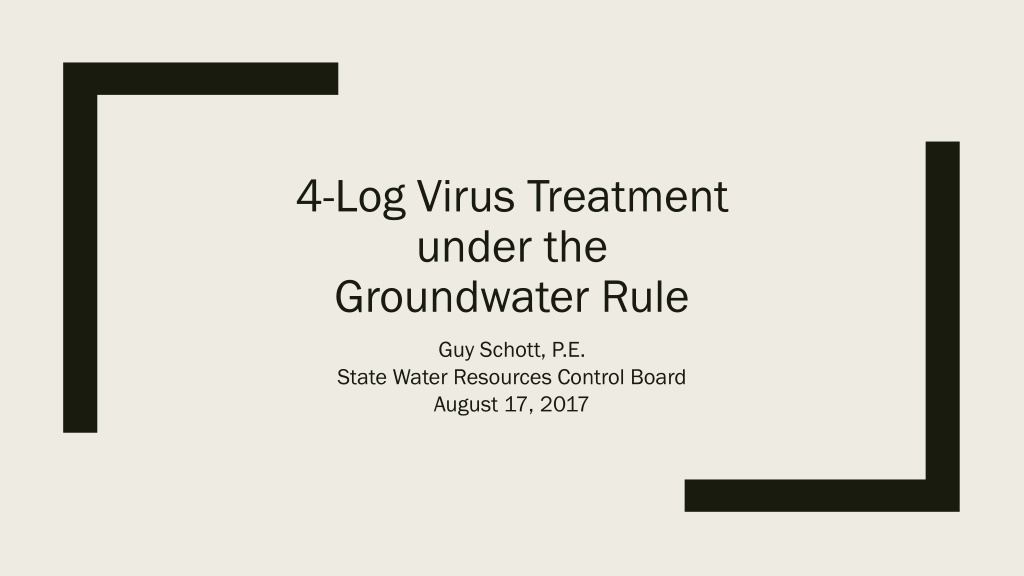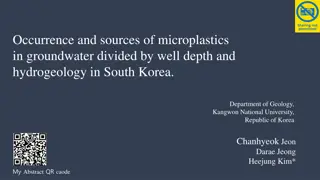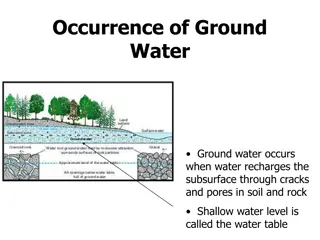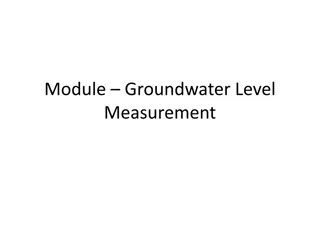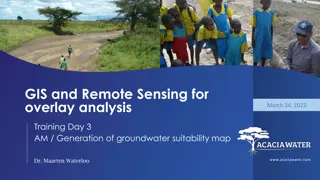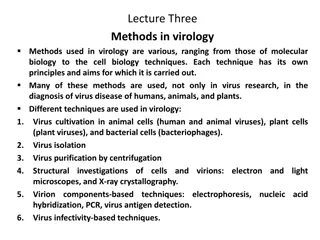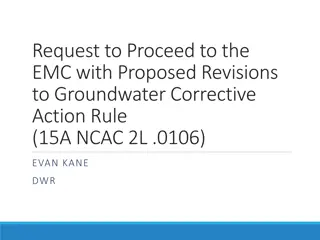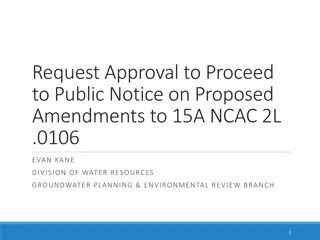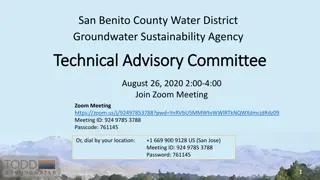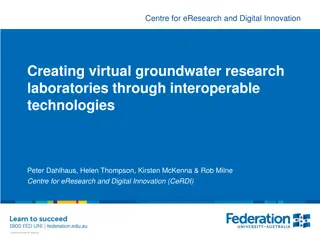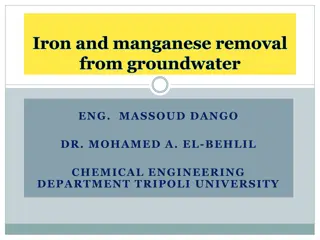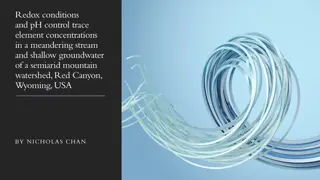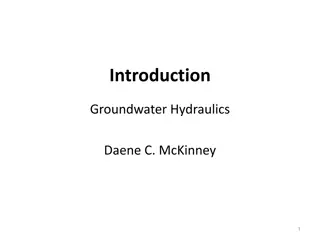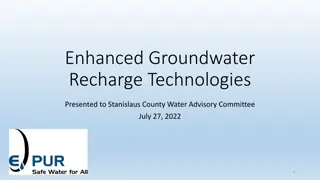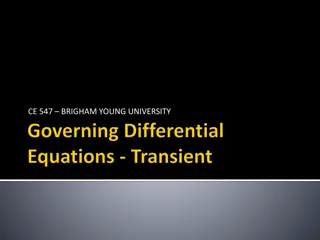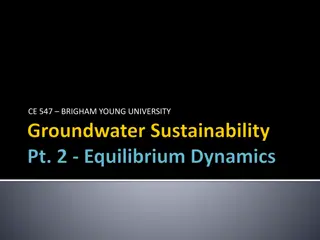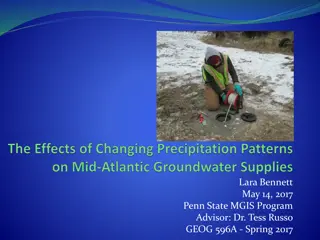Understanding 4-Log Virus Treatment and Groundwater Rule Compliance
This collection of images and information delves into the importance of 4-log virus treatment under the Groundwater Rule, regulatory requirements for groundwater systems, the basics of Ct calculations for disinfection, types of disinfectants used, and understanding log inactivation of viruses. The content emphasizes the need for proper virus removal and/or inactivation in water systems, with detailed explanations of log inactivation percentages and disinfection processes.
Download Presentation

Please find below an Image/Link to download the presentation.
The content on the website is provided AS IS for your information and personal use only. It may not be sold, licensed, or shared on other websites without obtaining consent from the author. Download presentation by click this link. If you encounter any issues during the download, it is possible that the publisher has removed the file from their server.
E N D
Presentation Transcript
4-Log Virus Treatment under the Groundwater Rule Guy Schott, P.E. State Water Resources Control Board August 17, 2017
Topics Groundwater Rule Source Waters Log Inactivation Types of Disinfectants Ct Basics Baffling Factor Ct & Log Inactivation Calculation Example Problems
Groundwater Rule Regulatory Requirements Groundwater Rule Groundwater Rule: Groundwater systems (GWS) that do not disinfect but do not get virus inactivation credit must conduct source water monitoring (E. coli) whenever they are notified of a total coliform positive (TC+) routing sample (Total Coliform Rule). do not provide disinfection or do As a result of the above rule, GWS may choose to provide 4 triggered source water E. coil monitoring due to a routine positive bacteriological distribution sample. provide 4- -log virus log virus treatment to forgo Groundwater systems with significant deficiencies may be required to disinfect to achieve 4-log inactivation of viruses. Fecal/E.coli Inadequate construction Near surface water source (possible influence)
Source Waters Vertical and Horizontal Wells Springs
Log Inactivation Understanding 4-Log Virus Treatment Virus treatment means virus removal and/or inactivation inactivation. Removal/inactivation of microorganisms, including viruses, generally is measured on logarithmic scale. Log inactivation of viruses relates to % inactivation 1-log inactivation = 9 out of 10 = 90% inactivation 2-log inactivation = 99 out of 100 = 99% inactivation 3-log inactivation = 999 out of 1,000 = 99.9% inactivation 4-log inactivation = 9,999 out of 10,000 = 99.99% inactivation % inactivation of viruses.
Type of Disinfectants Chlorine Most common for small water systems Ozone Ultraviolet Radiation (UV) Chlorine Dioxide Chloramines
Ct Ct Basics - Log inactivation is based on the Delivered Dose Delivered Dose, Ct Ct C C is the disinfectant residual (mg/L) t t is the exposure or contact time (minutes) Multiply them: C C t t = mg/L min (delivered dose) (delivered dose) The calculated Ct value is looked up in EPA inactivation based on specific monitoring parameters (pH, disinfectant residual and/or temperature). EPA Ct Ct tables to determine the log Ct value
Ct Table Inactivation of Viruses by Free Chlorine, pH 6.0-9.0 Inactivation Inactivation (log) (log) Temperature ( Temperature (o oC) C) 4 6 8 10 12 14 16 18 20 22 4 6 8 10 12 14 16 18 20 22 24 24 2 2 4.4 3.8 3.4 3.0 2.6 2.2 1.8 1.4 1.0 1.0 1.0 3 3 6.7 5.6 4.8 4.0 3.6 3.2 2.8 2.4 2.0 1.6 1.2 4 4 8.9 7.6 6.8 6.0 5.2 4.4 3.8 3.4 3.0 2.6 2.2 Calculated Ct is 4.5 mg/L*min Temperature: 10oC From Ct Table: The log inactivation is somewhere between 3 and 4.
Ct Ct Basics Disinfectant concentration C C is measured before the first customer or outlet of water system. Exposure or contact time t t is difficult of quantify. Theoretically, is calculated as (gal) V = = H (Hydraulic RT Residence Time) (gal/min) Q tank = flow = where V and/or pipe volume and Q rate V Q
Baffling Factor (BF) Q1 V1 mg/L (disinfectant, C) Cl2 Ct = mg/L min = V1/Q2 Q2 Baffling factor or short-circuiting factor (0.05 1): Determined from tracer study or estimated BF BF = t10/ from tracer study. t = BF
The Ct value is Analogous to UV Dose (It It) It Itis the product of UV light intensity and exposure time I I is in mW/cm2 (UV light Intensity) t t is in seconds (exposure time) I I t t = mW/cm2 seconds = mJ/cm2 (delivered dose) (delivered dose) It value
Calculating Ct and Log Inactivation Pipeline Contactor Pressure Tank Well Distribution System NaOCl Cl2 Daily grab ( 3,300 people) Continuous (> 3,330 people)
Pipeline Contactor Calculating Ct and Log Inactivation Calculated Ct: 1.6 mg/L 2.8 minutes = 4.5 mg/L (Delivered Dose) (Delivered Dose) Pipeline Length (L): 520 feet Pipeline Diameter (D): 2-in = 0.167-ft Well Flow: 30 gpm Pipeline Volume (Vol): ( ) 2 D 2 3.14 0.167 ft 7.48 gal 3 L = 520 gallons 85 = ft 4 4 ft Baffling Factor (BF) for Pipeline: 1.0 (assume plug flow) Pipeline Contact Time: (Vol BF)/flow = (85 gal 1)/(30 gal/min) = 2.8 minutes Measured Chlorine Residual: 1.6 mg/L 1.6 mg/L at water temperature of 14oC 2.8 minutes 4.5 mg/L minutes minutes
Ct Table Inactivation of Viruses by Free Chlorine, pH 6.0-9.0 Inactivation Inactivation (log) (log) Temperature ( Temperature (o oC) C) 4 6 8 10 12 14 16 18 20 22 4 6 8 10 12 14 16 18 20 22 24 24 2 2 4.4 3.8 3.4 3.0 2.6 2.2 1.8 1.4 1.0 1.0 1.0 3 3 6.7 5.6 4.8 4.0 3.6 3.2 2.8 2.4 2.0 1.6 1.2 4 4 8.9 7.6 6.8 6.0 5.2 4.4 3.8 3.4 3.0 2.6 2.2 Pipeline: Pipeline: Calculated Ct is 4.5 mg/L*min 4.4 mg/L*min (EPA Table) for temperature at 14oC at 4 log virus inactivation 4.5 > 4.4, therefore the water system is meeting at least 4 log virus inactivation.
Alternative Treatment UV Disinfection, 4-Log Virus Pressure Tank Well UV Distribution System Install UV Reactor that can achieve 4-log virus inactivation. UV Reactor must be validated in accordance with the 2006 USEPA UV Disinfection Guidance Manual (UVDGM). Contact: Anthony Oosterveld (519) 763-1032 or (519) 317-0428 aoosterveld@viqua.com , viqua.com
Storage Tank Contactor Calculating Ct and Log Inactivation Storage Tank Well Distribution System NaOCl Cl2 Daily grab ( 3,300 people) Continuous (> 3,330 people)
Storage Tank Contactor Calculating Ct and Log Inactivation Operating Tank Volume (Vol): 6,000 gallons Well Flow: 30 gpm Tank Flow: 80 gpm Baffling Factor (BF) for Tank: 0.1 Tank Contact Time: (Vol BF)/flow = (6,000 gal 0.1)/(80 gal/min) = 7.5 minutes 7.5 minutes Calculated Ct: 0.8 mg/L 7.5 minutes = 6.0 mg/L (Delivered Dose) (Delivered Dose) Measured Chlorine Residual: 0.8 mg/L 0.8 mg/L at water temperature of 12oC 6.0 mg/L minutes minutes
Ct Table Inactivation of Viruses by Free Chlorine, pH 6.0-9.0 Inactivation Inactivation (log) (log) Temperature ( Temperature (o oC) C) 4 6 8 10 12 14 16 18 20 22 4 6 8 10 12 14 16 18 20 22 24 24 2 2 4.4 3.8 3.4 3.0 2.6 2.2 1.8 1.4 1.0 1.0 1.0 3 3 6.7 5.6 4.8 4.0 3.6 3.2 2.8 2.4 2.0 1.6 1.2 4 4 8.9 7.6 6.8 6.0 5.2 4.4 3.8 3.4 3.0 2.6 2.2 Storage Tank: Storage Tank: Calculated Ct is 6.0 mg/L*min 5.2 mg/L*min (EPA Table) for temperature at 12oC at 4 log virus inactivation 6.0 > 5.2, therefore the water system is meeting at least 4 log virus inactivation.
Ozone Disinfection Calculating Ct & Log Inactivation Ozone Contactor Storage Tank Distribution System Well O3 O3 Daily grab ( 3,300 people) Continuous (> 3,330 people)
Ozone Disinfection Calculating Ct & Log Inactivation Operating Ozone Tank Volume (Vol): 1,000 gallons Well Flow: 30 gpm Baffling Factor (BF) for Tank: 0.4 Ozone Contact Time: (Vol BF)/flow = (600 gal 0.4)/(30 gal/min) = 8.0 minutes 8.0 minutes Calculated Ct: 0.2 mg/L 8.0 minutes = 1.6 mg/L (Delivered Dose) (Delivered Dose) Measured Ozone Residual: 0.2 mg/L 0.2 mg/L at water temperature of 10oC 1.6 mg/L minutes minutes
Ct Table Inactivation of Viruses by Ozone Inactivation Inactivation (log) (log) Temperature ( Temperature (o oC) C) 4 6 8 10 12 14 16 18 20 22 24 4 6 8 10 12 14 16 18 20 22 24 2 2 0.68 0.58 0.54 0.50 0.42 0.34 0.29 0.27 0.25 0.21 0.17 3 3 1.03 0.88 0.84 0.80 0.68 0.56 0.48 0.44 0.40 0.34 0.28 4 4 1.35 1.16 1.08 1.00 0.84 0.68 0.58 0.54 0.50 0.42 0.34 Ozone Tank: Ozone Tank: Calculated Ct is 1.6 mg/L*min 1.0 mg/L*min (EPA Table) for temperature at 10oC at 4 log virus inactivation 1.6 > 1.0, therefore the water system is meeting at least 4 log virus inactivation.
Log Inactivation Ct Comparisons (Delivered Dose) 1 1Disinfectant Disinfectant Delivered Dose Delivered Dose mg/L mg/L min 1.0 6.3 26.4 1,560 Virus Virus Log Log 4.0 4.0 4.0 4.0 Giardia cyst Giardia cyst Log Log 2.0 Cryptosporidium Cryptosporidium Log Log 0.09 - 0.09 - min Ozone 2Chlorine 30.09 0.24 3.4 2.4 4Chlorine Dioxide 2Chloramines 1Temperature at 9oC; 2MRDL: = 4.0 mg/L as Cl2 3pH: 6-9; 4MRDL = 0.8 mg/L as ClO2
UV Log Inactivation Disinfectant Disinfectant Delivered Dose Delivered Dose mW mW/cm /cm2 2 sec ( (mJ/cm mJ/cm2 2) ) Virus Virus Log Log Giardia cyst Giardia cyst Log Log Cryptosporidium Cryptosporidium Log Log sec Ultraviolet Radiation (UV) 186 4.0 4.0 4.0
Website https://www.waterboards.ca.gov/ Drinking Water Drinking Water Field Operations Branch Districts Mendocino District 03 CT Spreadsheets CT Presentations
